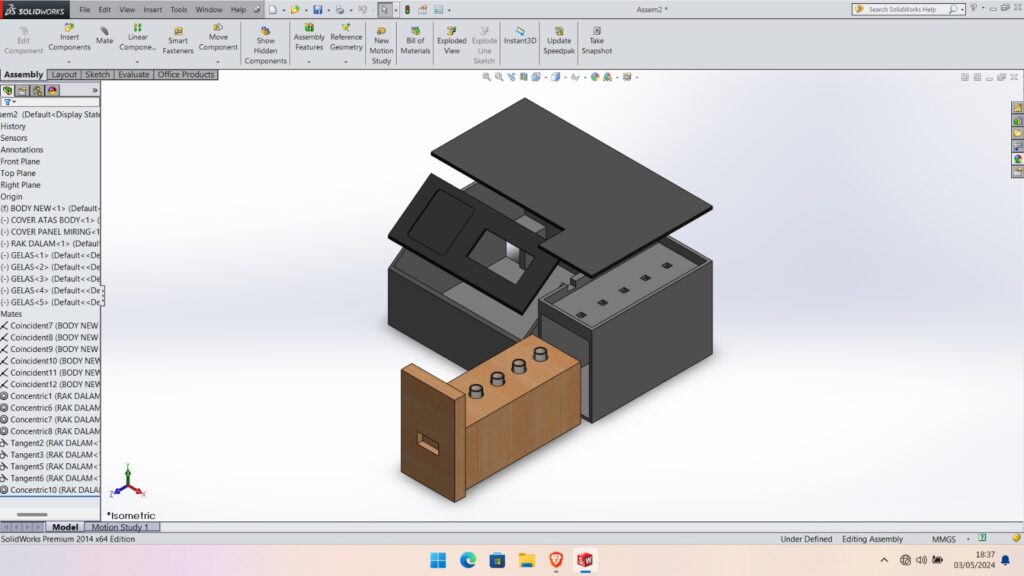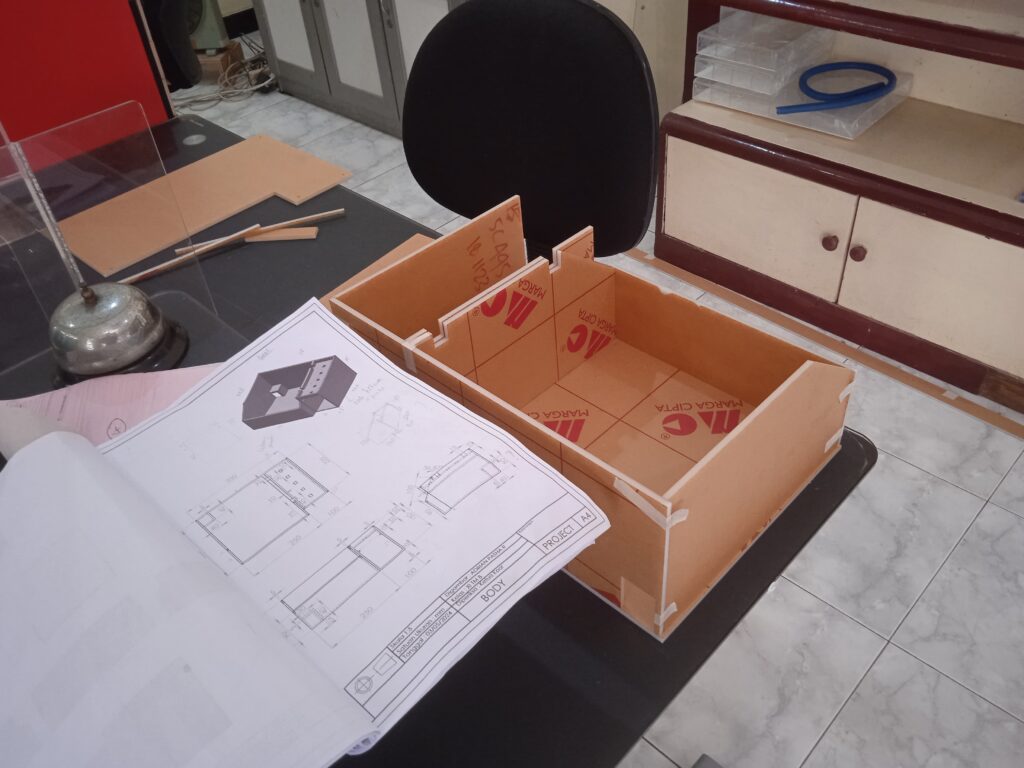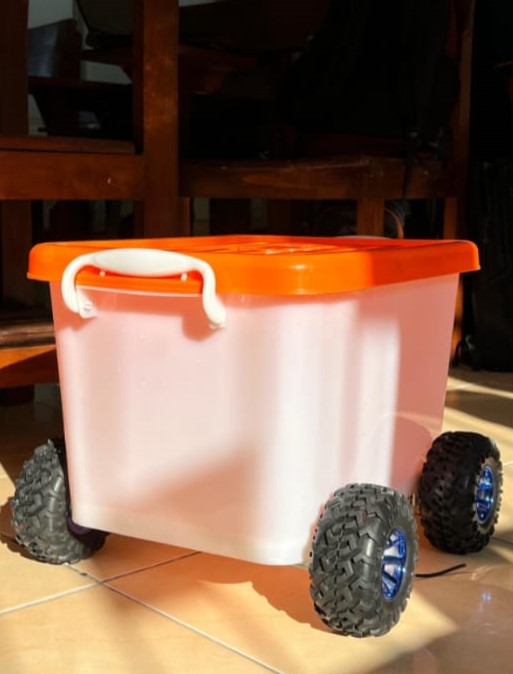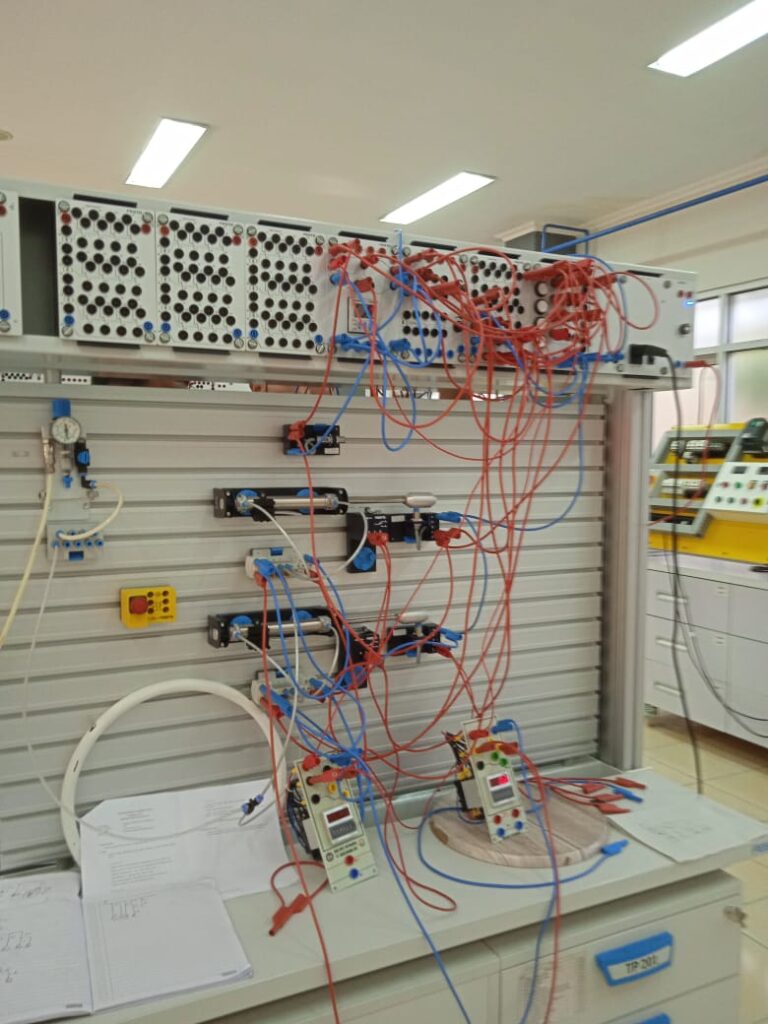HAns's project
alcohol detector
Hans was also actively involved in various school and departmental projects. One of the projects he worked on with his team was an alcohol detection device, a collaboration between two departments: Chemical Analysis and Mechatronics Engineering. The goal of this project was to create a tool capable of detecting the alcohol content in test objects. The Chemical Analysis students developed a reagent that changes color based on alcohol levels, while the Mechatronics team designed a system to read the resulting color, convert it into a corresponding alcohol percentage, and display the data digitally.
In this project, Hans served as the drafter. He was responsible for creating the initial design of the device, determining the dimensions based on its components such as microcontrollers, sensors, and cables. Hans also discussed his design with both his teammates and department supervisors to ensure it met their expectations. After completing the drawings, Hans submitted them to the acrylic vendor to manufacture the device casing. During this process, he faced communication challenges since the technical drawings used engineering conventions that were unfamiliar to the vendor. This led to several days of back-and-forth discussions to align the final output with the original plans.
Once the casing was completed, Hans handed it over to the electrical and programming teams for installation and system testing. These teams integrated the color sensor system with the microcontroller programming to ensure the detected alcohol levels could be displayed on both a local LCD and a web interface. Testing was done step-by-step to verify the accuracy and stability of the entire system. This stage was crucial to determine the device’s readiness for presentation.
The alcohol detection tool was then showcased at the P5 Exhibition (Pancasila Student Profile Reinforcement Project) held at SMK SMTI Yogyakarta. This event was significant as it was open to the public and attended by parents, officials from the Ministry of Industry, and other visitors during the school’s open house. The project, built by Hans and his team amidst their busy schedules, received a great deal of praise from teachers and exhibition attendees for its creativity and potential real-world applications.
Despite the positive feedback, the project was not without constructive criticism. Comments and suggestions from teachers and visitors served as valuable input for future improvements. This interdisciplinary project provided not only technical experience but also taught important lessons in cross-departmental collaboration, communication, and time management. Hans felt proud to have contributed to the project and saw it as a strong motivation to continue developing his skills through future innovations.


delvery box
At the same time Hans was working on the alcohol detection joint project, he also participated in a class project under the Mechatronics Engineering department to develop a delivery box robot. This robot was designed to transport various items such as books, tools, and laboratory equipment across the SMK SMTI Yogyakarta campus. Users could simply input a destination, and the robot would automatically navigate to the specified location. The prototype was thoroughly tested on different floor surfaces on the first level of the school building, ensuring stability and functionality even on uneven ground.
Hans contributed as a drafter during the early stages of the project. He proposed the initial concept and created the basic mechanical design, especially focusing on the wheel system and structural mechanism. However, due to some miscommunication within the drafting team and his prioritization of the alcohol detection project, Hans did not complete the full technical drawing of the robot. Nonetheless, his contributions helped shape the foundation of the project. Interestingly, the core idea of the delivery box robot was originally Hans’s, who initially suggested a floor-cleaning robot. After further discussions, the team decided that a delivery-focused robot would be more feasible.
Hans had also proposed that the robot be capable of ascending and descending stairs, considering the school building has three floors. However, due to budget and time constraints, the team limited the robot’s operation to the first floor. Thanks to the hard work and collaboration of the entire team, the robot was selected to represent the Mechatronics Engineering department at an external exhibition in Solo. The project received positive attention and enthusiasm from the broader SMK SMTI Yogyakarta community.

school projects
The education system at SMK SMTI Yogyakarta adopts a distinctive approach compared to most vocational schools. The school implements a weekly block schedule, in which one technical subject must be completed within a single week. At the beginning of the week, students receive instructional material, followed by assessments in the middle and at the end of the week. Frequently, students are also assigned technical projects that must be presented.
With this learning system, Hans has successfully completed a variety of technical projects throughout his studies. Some of the projects he worked on include a fire detection system using Arduino, an automatic parking counter system using Python, an automated garage system with PLC, and an IoT-based monitoring system for agriculture. These projects not only sharpened Hans’s practical skills in automation and programming but also enhanced his ability to design and integrate complex systems.
In addition to designing systems from scratch, Hans has also modified existing educational systems, such as the MAS 200—an instructional tool used in the mechatronics laboratory. He enhanced the system by adding new features such as a safety mechanism and the ability to switch between manual and automatic modes. He utilized PLC programming or ladder diagrams to implement these improvements, making the system more flexible and safer for educational use.
Hans possesses in-depth expertise in pneumatic and electropneumatic systems. He is able to read and interpret pneumatic flow diagrams, understand the working principles of valves, and design pneumatic cylinder systems with various modifications such as sensor integration, counters, emergency stops, and timers. These capabilities make Hans proficient in developing precise and efficient actuation systems tailored to industrial needs.
Beyond automation, Hans also has extensive experience in industrial electricity. He has designed and implemented three-phase motor control systems, constructed single-phase motor control circuits, and developed three-phase power systems with various configurations, including forward-reverse controls and other automated features. These experiences demonstrate Hans’s strong technical foundation and his ability to apply theoretical knowledge to real-world industrial applications effectively.
